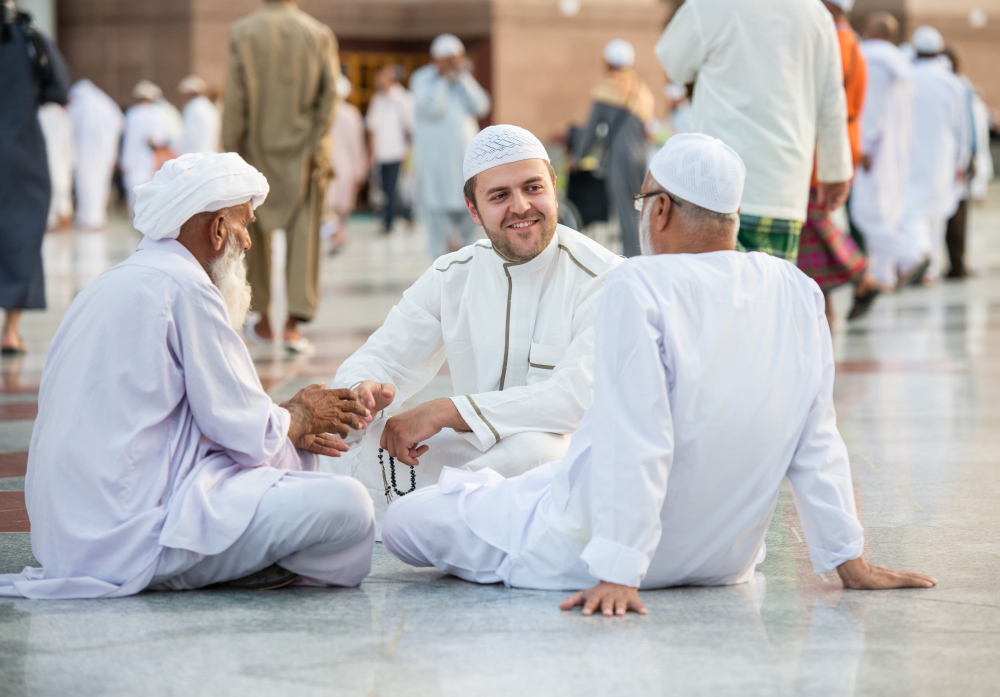Hajj (Arabic: حج), the pilgrimage to Makkah, is a cornerstone of Islamic faith, representing one of the five pillars alongside the declaration of faith, prayer, fasting, and almsgiving. This sacred journey is required of all Muslims once in their lifetime, provided they have the physical and financial means.
Definition of Hajj
Hajj, derived from the Arabic verb “hajja” (حَجَّ), signifies the effort made in journeying to a significant place. In Islamic law, it refers to the pilgrimage to the Kaaba within the Masjid al-Haram and other sacred sites in and around Makkah including Arafat, Mina, and Muzdalifah during specific months such as Shawwal, Dhul Qadah, and the first ten days of Dhul Hijjah. Pilgrims engage in rites such as Tawaf, Sa’i, and Rami al-Jamarat during this time.
Obligation of Hajj
Quran
The Quran declares Hajj a mandatory duty for those who are able, as evidenced by the verse in Surah Aal Imran (3:97):
“فِيهِ آيَاتٌ بَيِّنَاتٌ مَقَامُ إِبْرَاهِيمَ وَمَنْ دَخَلَهُ كَانَ آمِنًا وَلِلّٰهِ عَلَى النَّاسِ حِجُّ الْبَيْتِ مَنِ اسْتَطَاعَ إِلَيْهِ سَبِيلًا وَمَنْ كَفَرَ فَإِنَّ اللهَ غَنِيٌّ عَنِ الْعَالَمِينَ”
This stresses the importance of intention and the means to undertake the journey. The obligation is thought to have been established around the sixth year after the Prophet Muhammad’s migration to Medina, as further supported by Surah al-Baqarah (2:196).
Hadith
Prophetic traditions reinforce the compulsory nature of Hajj. Notably, Abu Huraira reports the Prophet Muhammad ﷺ as stating, “O people, Allah has made Hajj obligatory for you; so perform Hajj.” (Sahih Muslim)
Virtues of Hajj
Hajj serves as a profound spiritual cleansing, an act of penance that purifies pilgrims of sin, restoring them as if they were newly born. The Hadith literature is replete with references to the rewards of Hajj, which if accepted, guarantees paradise.
Conditions of Hajj
To participate in Hajj, a Muslim must be of sound mind, mature, and free. Women must have a Mahram or, according to some schools, trustworthy female companions. The pilgrimage should be performed as soon as the Muslim is able, both physically and financially.
Historical Background
Hajj traces back to the Prophet Ibrahim, who built the Kaaba with his son Ismail. Over millennia, the monotheistic practices established by Ibrahim were diluted until they were purified and reinstated by the Prophet Muhammad ﷺ.
Types of Haj
1. **Hajj al-Tamattu**: Pilgrims perform Umrah, then Hajj, taking a break in between.
2. **Hajj al-Qiran**: Pilgrims combine Umrah and Hajj without a break, maintaining Ihram throughout.
3. **Hajj al-Ifrad**: Pilgrims perform only the Hajj.
Preparation for Hajj
Preparation involves extensive logistical, physical, and spiritual planning, often beginning months in advance. It encompasses travel arrangements, securing visas, health care provisions, and understanding the detailed rituals to be performed.
Jurisprudence of Hajj
The juridical aspects emphasize performing all rites correctly, with missed obligations requiring fidya (compensation). Key rites include the stand at Arafat and Tawaf al-Ifadah, essential for the Hajj’s validity.
The History of Hajj
The origins of Hajj trace back to the second millennium BCE, rooted deeply in the actions of the Prophet Ibrahim (عليه السلام). He had two sons, Ishaq (عليه السلام) and Ismail (عليه السلام), the latter of whom is considered a forefather of the Arab tribes and an ancestor of the Prophet Muhammad (صلى الله عليه وسلم).
The Ritual of Sa’i
After the birth of Ismail, Ibrahim (عليه السلام) was commanded by Allah to leave his wife Hajar and his son in the desert. As their provisions dwindled, Hajar, in her quest for water, ran seven times between the hills of Safa and Marwa. This act of desperation and faith is commemorated by pilgrims who perform the Sa’i between these hills during both Hajj and Umrah.
Miraculously, the Angel Jibril (عليه السلام) brought forth a spring of water from the ground, known today as Zamzam, around which the community of Makkah eventually developed. Later, Ibrahim (عليه السلام) returned to Makkah, and he and Ismail (عليه السلام) constructed the Kaaba as a monument dedicated to the worship of the one true God, marking it a central place of pilgrimage.
The Decline into Idolatry
Over centuries, the monotheistic practices instituted by Ibrahim (عليه السلام) devolved into idolatry and polytheism during what is known as the Jahiliyyah (Age of Ignorance). The Kaaba was surrounded by 360 idols worshipped by the pre-Islamic Arab tribes, and rituals including the Tawaf were corrupted with idolatrous practices.
The Prophetic Restoration
In 610 CE, the Prophet Muhammad (صلى الله عليه وسلم) began receiving revelations from Allah, which included commands to restore monotheism and cleanse the Kaaba of idols. By 630 CE, with enough religious and political influence, the Prophet (صلى الله عليه وسلم) achieved victory in Makkah, purging the Kaaba of its idolatrous past and rededicating it as a place of monotheistic worship.
The Farewell Hajj
In 623 CE (10 AH), the Prophet Muhammad (صلى الله عليه وسلم) led his only Hajj, known as Hajjat al-Wida. Addressing a large gathering of his followers at Jabal Arafat, he delivered a seminal sermon emphasizing equality, unity, and the sanctity of life and property, which remain central to the values of the Hajj pilgrimage today. This farewell sermon at Jabal al-Rahma (جبل الرحمة) marked a defining moment in Islamic history.
Types of Hajj
- Hajj al-Tamattu: The pilgrim performs Umrah during the Hajj months (Shawwal, Dhul Qadah, and the first ten days of Dhul Hijjah) followed by Hajj. It is noted for allowing pilgrims to enjoy normal life between the rituals.
- Hajj al-Qiran: This involves combining Hajj and Umrah without a break in between, under a single Ihram.
- Hajj al-Ifrad: Pilgrims perform only Hajj. It is often chosen by residents of Makkah or those living nearby.
Each type of Hajj has specific rites and obligations, dictated by traditions and scholarly interpretations, and is chosen based on individual circumstances and spiritual goals. Each form adheres to the profound rituals established since the time of Prophet Ibrahim (عليه السلام) and re-emphasized by the Prophet Muhammad (صلى الله عليه وسلم).


